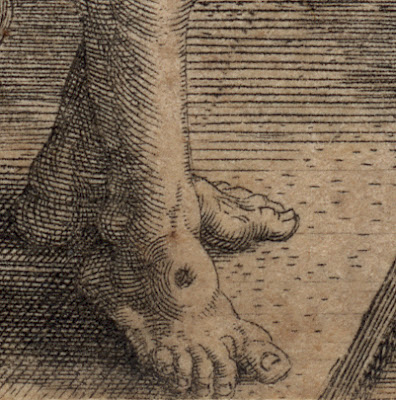Aegidius
Sadeler II (aka Gillis Sadeler; Egidius Sadeler; Ægedius Sadeler)
(c1570–1629)
“Christ as the Man of Sorrows at the Column” (TIB title), 1585–1627,
plate 1 from the series of 16 plates, “The Engraved Passion”, after Albrecht Dürer (1471–1528). This is an
impression from the first state before publication by Marco Sadeler (fl1660s)
Engraving on fine laid paper trimmed close to the platemark and re-margined
on a support sheet.
Size: (support-sheet) 26.9 x 21.2 cm; (sheet trimmed unevenly) 9 x
5.5 cm
State i (of iii?) (before addition of the publication details of
Marco Sadeler)
TIB 1997 7201.425 SI (Isabelle de Ramaix, “The Illustrated
Bartsch”, vol. 72, Part 2, Supplement, p. 320); Bartsch VII.33.3 (copy) (Adam Bartsch
1803, “Le Peintre graveur”, 21 vols, Vienna); Meder 1932 3 (copy) (Joseph Meder
1932, “Dürer Katalog”, Vienna).
The British Museum offers the following description of a later
state of this print:
“Plate 1: Christ as a man of sorrows. Christ tied to a column on a
platform at left, the Virgin and St John looking at him from below at right,
three empty crosses on a hill in background at right; after Dürer”
Condition: a lifetime impression that is crisp and well-printed in
excellent condition (i.e. there are no tears, holes, significant abrasions or significant
stains) apart from golden age toning. The sheet is trimmed close to the platemark
and has been re-margined with an archival support sheet.
I am selling this lifetime (first state) impression in reverse
after Dürer’s engraving of the same subject for AU$378 (currently US$300.07/EUR240.75/GBP212.47
378 at the time of posting this listing). Postage for this print is extra and
will be the actual/true cost.
If you are interested in acquiring this small print that is so
finely rendered that to see the linework a magnifying glass is necessary, please
contact me (oz_jim@printsandprinciples.com) and I will send you a PayPal
invoice to make the payment easy.
This print has been sold
Although this remarkably fine engraving by Aegidius Sadeler is a
copy in reverse after Albrecht Dürer’s famous engraving executed
a century before (see https://www.ngv.vic.gov.au/explore/collection/work/43261/)
the subject, “The Man of Sorrows”, was a part of a long tradition of depicting
this subject dating back to the early Byzantine icons of the 13th
century featuring what is termed, “Imago Pietatis” (i.e. Christ of Pity) (see
http://caravaggista.com/2011/08/albrecht-durer-and-the-man-of-sorrows/).
From what I understand about this tradition, there were two
manifestations of the subject. The first is to represent Christ before his
passion looking at the viewer with a look of betrayal. The second, shown here,
is to represent Christ after his passion with downcast eyes alluding to his
suffering.
Like most of the earlier representations of “The Man of Sorrows”, Christ is shown with the attributes of his passion (i.e. enduring suffering):
- the column on which Christ was scourged;
- the instruments of Christ’s torture—the birch reeds, flagellum, crown of thorns and the cross, but the nails that are usually featured are not represented in this image even if the holes in his feet and hands are testament to their presence;
- his nakedness and wounds—note the blood spurting from wound created by the soldier’s lance;
- his companions at death—the Virgin and St John.









No comments:
Post a Comment
Please let me know your thoughts, advice about inaccuracies (including typos) and additional information that you would like to add to any post.